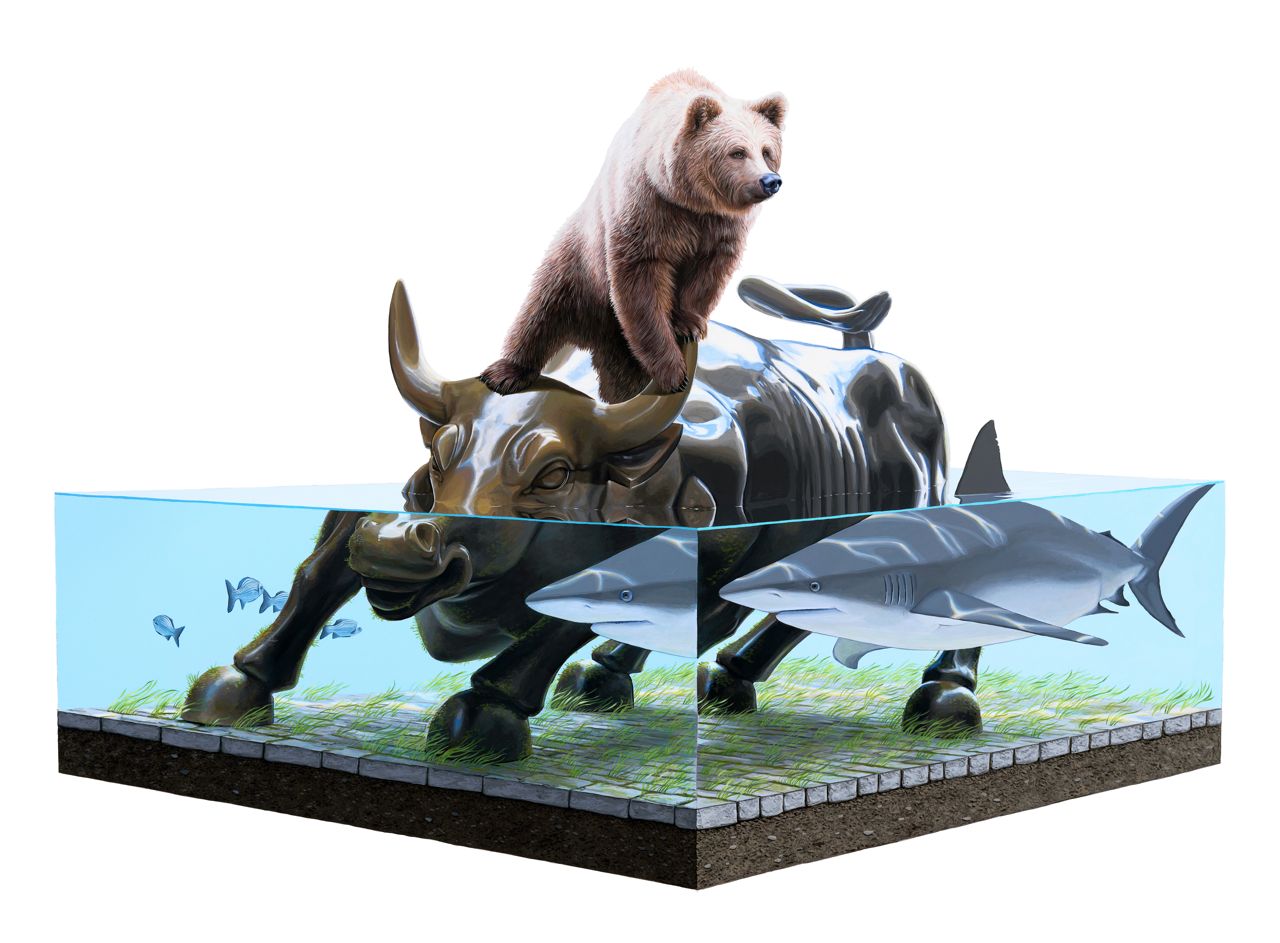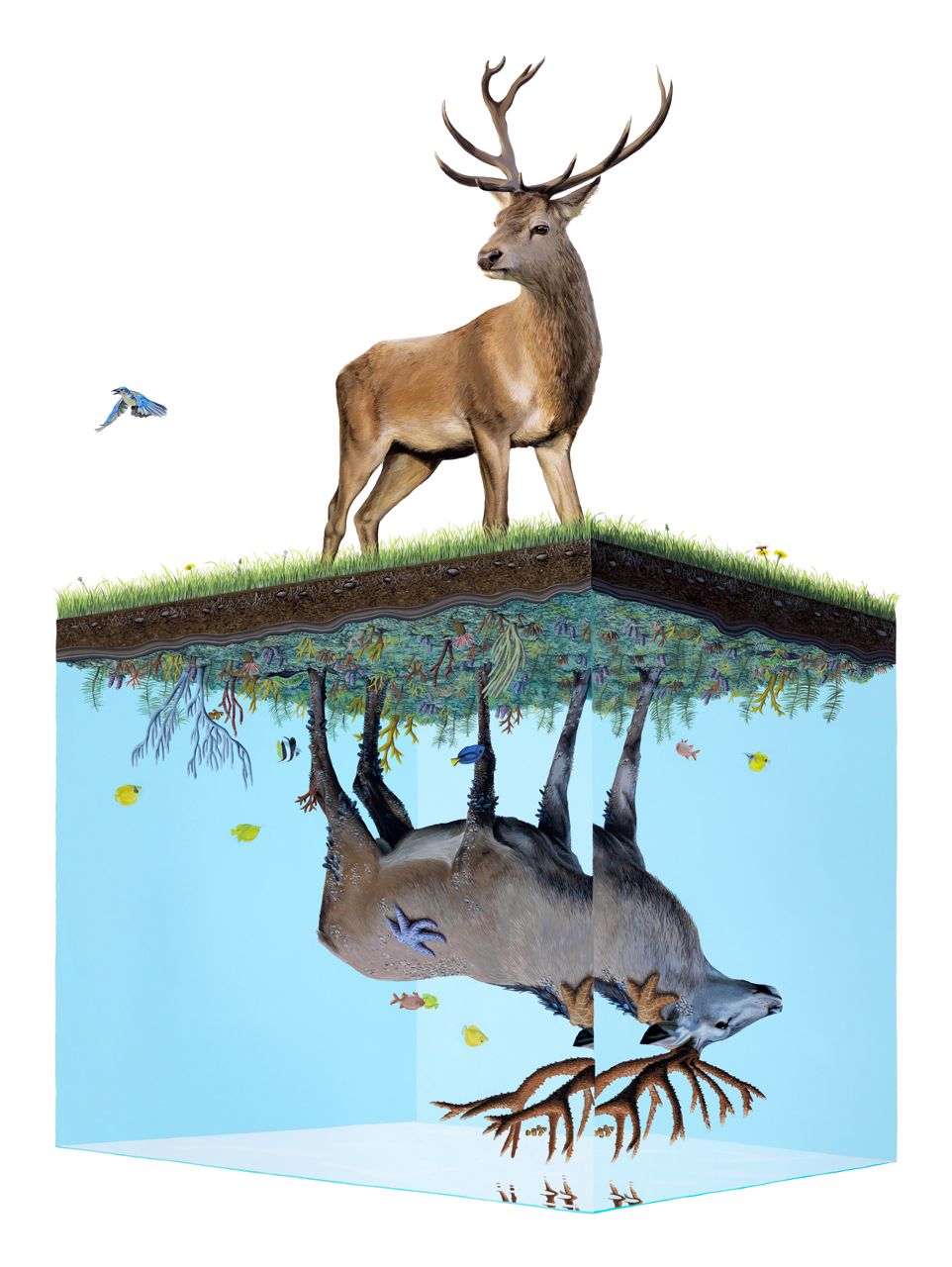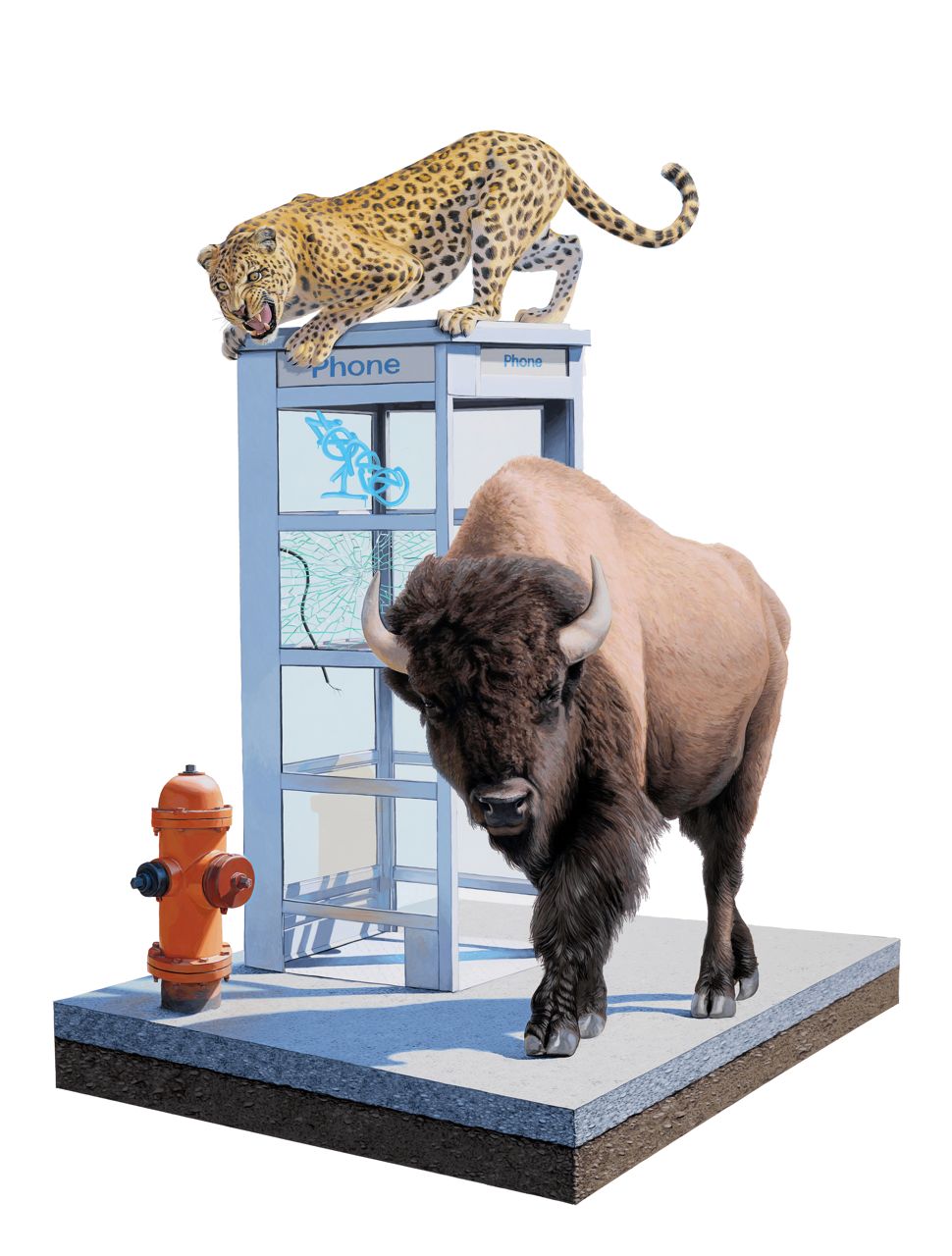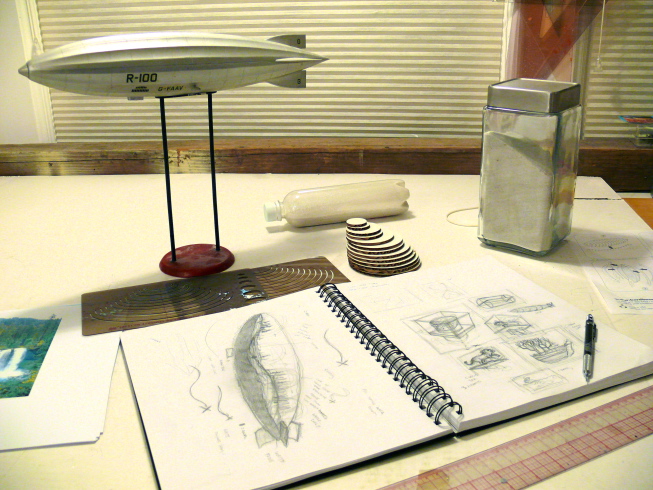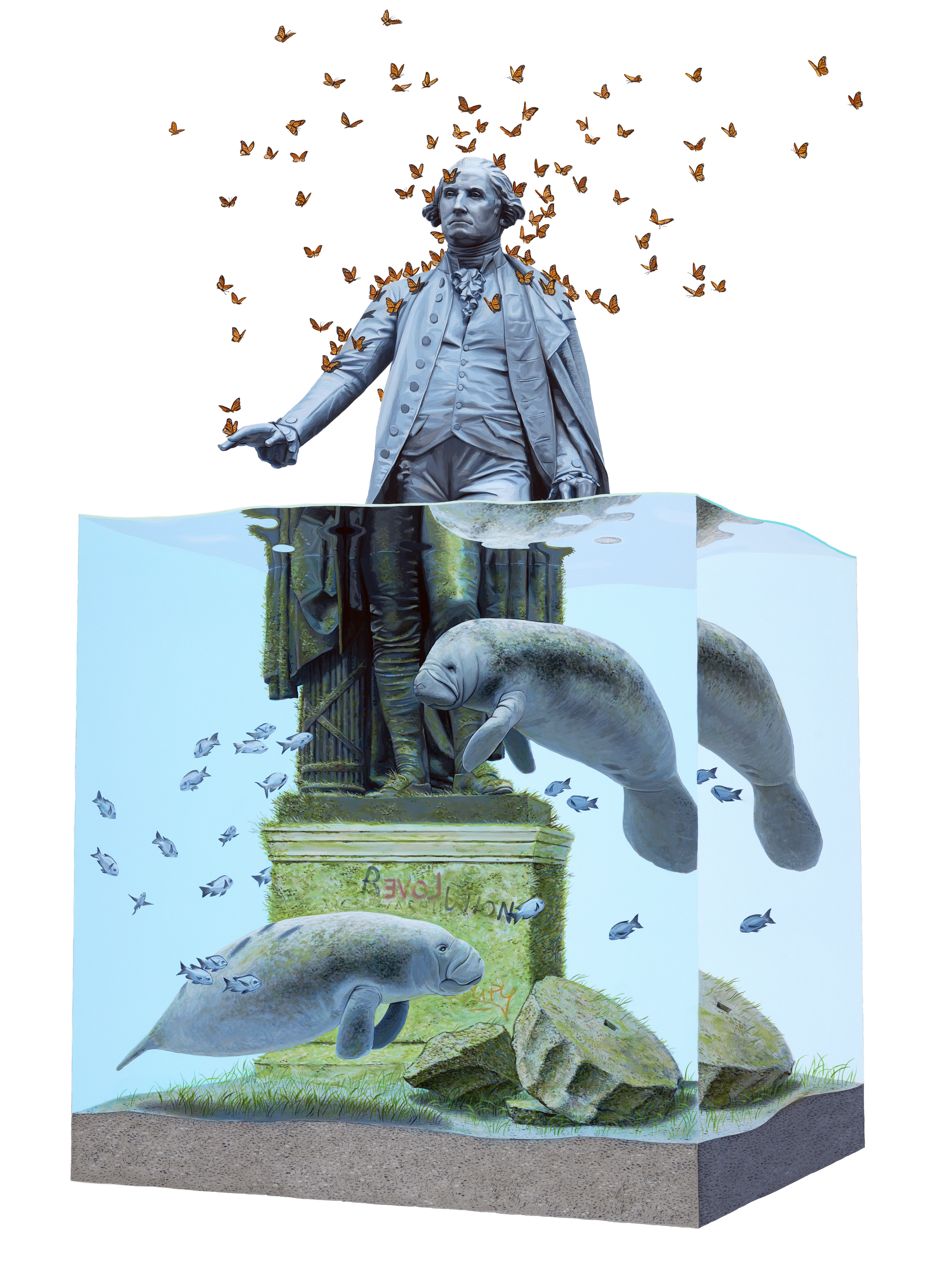Next Monday, May 21st in Tucson, the newest exhibition from Josh Keyes will be open for public enjoyment at the Joseph Gross Gallery. The showing at the University of Arizona will be the first solo for the Portland-based painter at an academic associated gallery and as such he will be displaying a selection of old and new work which could be instructive on how artistic style changes and develops over time. We haven’t had a chance to sit down with Josh for some questions and answers since our last interview in 2010 so we thought it would be nice to get his thoughts behind his new paintings among other things. You can see entire session below as well as some preview images and studio shots. Also, for those interested in meeting Josh, the opening reception is actually on August 30th.
Arrested Motion (AM): Can you tell us a little about this newest show and the title Above and Below? Also, this showing will be at an art gallery associated with the University of Arizona. Does holding this exhibition in an academic setting come into play at all in terms of decisions on what to paint or how the show was planned out?
Josh Keyes (JK): This is a special show for me, the fact that it will be held in a university gallery gave me the chance to share with the students first hand, a sample of my artistic evolution and style as a painter. The title Above and Below refers to my ongoing fascination with cross sectional views and diagrammatical representation. The show will showcase a selection of old and new work.
AM: Although you still predominately feature creatures you are more familiar with in the North American setting, recent shows have seen you branch out to animals like lions, elephants, and panda bears. Has this been always part of your plan, a natural progression, or was there something new that prompted this?
JK: Recently I have added a few new members and species to the cast, and will include even more in the future, but for me, the North American ecology and animals have been, and will continue to be the primary references and characters in my work. For me, the integration comes from a place of speculation of how these different animals can appear or coexist in the same area. This often falls into the realm of dystopia, where ideas such as abandoned zoos and shifting migration patterns are the stem for this imagery.
AM: You often incorporate some local imagery into your work. Any such inspirations from Arizona make it into your paintings this time?
JK: I did not have any specific desert imagery to bring to this show. I did sketch out a number of ideas but nothing felt ready to come to life yet. I imagine a piece with a desert theme will emerge down the road, perhaps for another show in the Southwest.
AM: In the past, you have created installations with three-dimensional elements to round out bodies of work at your shows. Any plans for something like that for this show or in the future?
JK: I have many ideas for sculptures, but my focus remains on the painting for the moment.
AM: Speaking of sculptural aspects to your work. Have you ever considered producing and releasing some sort of limited edition three-dimensional representations of your imagery? If so, would it be a completely new piece or are there particular paintings you have done in the past that you feel would be suited to such a project?
JK: I have thought of creating small statues, and think there are many of my paintings that would translate very well into a three-dimensional form. For me it is a challenge of time and process. It is definitely a project I would like to work on in the next few years.
AM: It sounds like like any artist, you are filled with ideas and are interested exploring other aspects of your work but don’t have enough time. Have you ever utilized or plan to use studio assistants? Any thoughts on you yourself or other artists who go this route to produce larger scale work and as a means of increasing output?
JK: There are many artists whose work I admire who do use assistants or other means to create installations, or take on larger projects. Artists such as Jeremy Fish, Kaws, Jeff Soto, dare I say Damien Hirst, and a number of others do this very well. It is an area that I would like to investigate, and my plan is to give form to some of the projects that I have in mind in the future. One idea, is the limited edition sculpture project, I think this could be really interesting to develop.
AM: We have you seen you experiment with larger and larger canvases culminating with at 10′ x 5′ piece for your Jonathan Levine show. Any plans to go big or even larger in the future? What kind of concepts do you feel you can get across better with more surface area? On a related not, how do you decide what size of a painting a certain idea you may have deserves?
JK: I enjoy the challenge of working on a large scale. I think the challenge is to find the right content, and energy that fits the scale. For the moment, I think Stampede, which will be on display at the show, is about as large as I would like to go. It’s also the largest size canvas that will fit in my studio, this is always a key factor to what scale an artist works on. I tend to feel at home with an easel-sized painting, something about arms length in width. There is for me an intimacy to this size, it feels like a personal space can open between the viewer and the work, that starts a conversation.
AM: Will you be giving any lectures or discussion sessions in association with this show at the Joseph Gross Gallery?
JK: I will be doing studio visits with the art students. This is something I am looking forward to. In my past life, I was a painting and drawing teacher, so I think it will be a good exchange to see and hear what this new generation is thinking about. So much has changed since I was an art student at the Chicago Art Institute, for one, there was no internet, and at the time the British figure painters, and Terry Winters, Robert Longo, and some guy named Damian Hirst, and were all the rage. I am hoping to share my experience as a painter and artist with the students, and to discuss everything from studio practice to marketing their artwork, or whatever is on their mind.
AM: Any other upcoming shows or projects you can tell your fans about for the rest of the 2012 and beyond?
JK: I have a show with the painter John Brophy in November at the Roq La Rue Gallery in Seattle. John’s work is incredible and in talking with him, it was interesting to find out that we both work in a very similar way in terms of our technical process and strategy for developing a painting. I recommend checking his work out if you are not familiar with it. My other plans are to release new limited editions, and the imagery for these new prints are selected using a combination of votes from polls on the Josh Keyes forum and through Facebook. For future plans, I suggest joining my mailing list, there are often special events that come up that are a surprise even to me.
AM: We would be remiss if on behalf of your many fans in Los Angeles and the UK, we did not ask you about the possibilities of a future show where they would be able to see a body of work of yours in person. Any plans as of yet for something like this?
JK: Yes, I would welcome the opportunity to do both. LA is such a mysterious and hyper-real place to me, and with the UK, I think I would have a great time incorporating the local landmarks into my work.
AM: Good to hear Josh. Best of luck with this newest show and hope to see you in Arizona.
Discuss Josh Keyes here.



